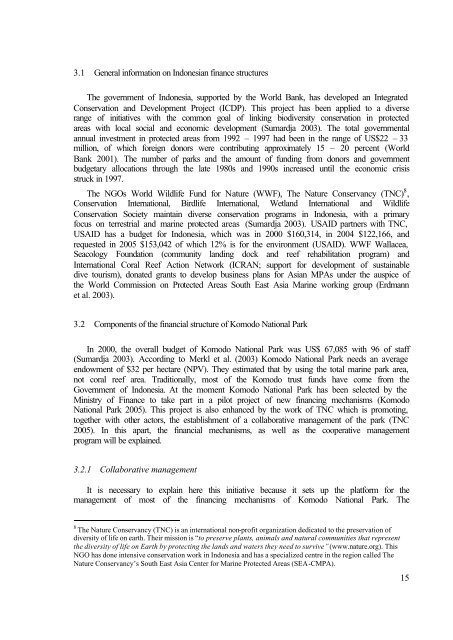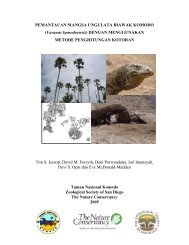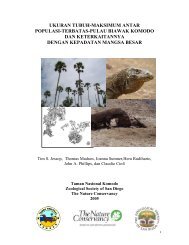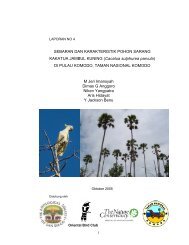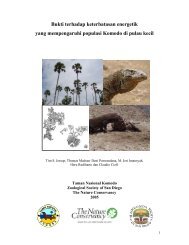Sustainable Financing of MPAs - Komodo National Park
Sustainable Financing of MPAs - Komodo National Park
Sustainable Financing of MPAs - Komodo National Park
Create successful ePaper yourself
Turn your PDF publications into a flip-book with our unique Google optimized e-Paper software.
3.1 General information on Indonesian finance structures<br />
The government <strong>of</strong> Indonesia, supported by the World Bank, has developed an Integrated<br />
Conservation and Development Project (ICDP). This project has been applied to a diverse<br />
range <strong>of</strong> initiatives with the common goal <strong>of</strong> linking biodiversity conservation in protected<br />
areas with local social and economic development (Sumardja 2003). The total governmental<br />
annual investment in protected areas from 1992 – 1997 had been in the range <strong>of</strong> US$22 – 33<br />
million, <strong>of</strong> which foreign donors were contributing approximately 15 – 20 percent (World<br />
Bank 2001). The number <strong>of</strong> parks and the amount <strong>of</strong> funding from donors and government<br />
budgetary allocations through the late 1980s and 1990s increased until the economic crisis<br />
struck in 1997.<br />
The NGOs World Wildlife Fund for Nature (WWF), The Nature Conservancy (TNC) 8 ,<br />
Conservation International, Birdlife International, Wetland International and Wildlife<br />
Conservation Society maintain diverse conservation programs in Indonesia, with a primary<br />
focus on terrestrial and marine protected areas (Sumardja 2003). USAID partners with TNC,<br />
USAID has a budget for Indonesia, which was in 2000 $160,314, in 2004 $122,166, and<br />
requested in 2005 $153,042 <strong>of</strong> which 12% is for the environment (USAID). WWF Wallacea,<br />
Seacology Foundation (community landing dock and reef rehabilitation program) and<br />
International Coral Reef Action Network (ICRAN; support for development <strong>of</strong> sustainable<br />
dive tourism), donated grants to develop business plans for Asian <strong>MPAs</strong> under the auspice <strong>of</strong><br />
the World Commission on Protected Areas South East Asia Marine working group (Erdmann<br />
et al. 2003).<br />
3.2 Components <strong>of</strong> the financial structure <strong>of</strong> <strong>Komodo</strong> <strong>National</strong> <strong>Park</strong><br />
In 2000, the overall budget <strong>of</strong> <strong>Komodo</strong> <strong>National</strong> <strong>Park</strong> was US$ 67,085 with 96 <strong>of</strong> staff<br />
(Sumardja 2003). According to Merkl et al. (2003) <strong>Komodo</strong> <strong>National</strong> <strong>Park</strong> needs an average<br />
endowment <strong>of</strong> $32 per hectare (NPV). They estimated that by using the total marine park area,<br />
not coral reef area. Traditionally, most <strong>of</strong> the <strong>Komodo</strong> trust funds have come from the<br />
Government <strong>of</strong> Indonesia. At the moment <strong>Komodo</strong> <strong>National</strong> <strong>Park</strong> has been selected by the<br />
Ministry <strong>of</strong> Finance to take part in a pilot project <strong>of</strong> new financing mechanisms (<strong>Komodo</strong><br />
<strong>National</strong> <strong>Park</strong> 2005). This project is also enhanced by the work <strong>of</strong> TNC which is promoting,<br />
together with other actors, the establishment <strong>of</strong> a collaborative management <strong>of</strong> the park (TNC<br />
2005). In this apart, the financial mechanisms, as well as the cooperative management<br />
program will be explained.<br />
3.2.1 Collaborative management<br />
It is necessary to explain here this initiative because it sets up the platform for the<br />
management <strong>of</strong> most <strong>of</strong> the financing mechanisms <strong>of</strong> <strong>Komodo</strong> <strong>National</strong> <strong>Park</strong>. The<br />
8 The Nature Conservancy (TNC) is an international non-pr<strong>of</strong>it organization dedicated to the preservation <strong>of</strong><br />
diversity <strong>of</strong> life on earth. Their mission is “to preserve plants, animals and natural communities that represent<br />
the diversity <strong>of</strong> life on Earth by protecting the lands and waters they need to survive” (www.nature.org). This<br />
NGO has done intensive conservation work in Indonesia and has a specialized centre in the region called The<br />
Nature Conservancy’s South East Asia Center for Marine Protected Areas (SEA-CMPA).<br />
15


